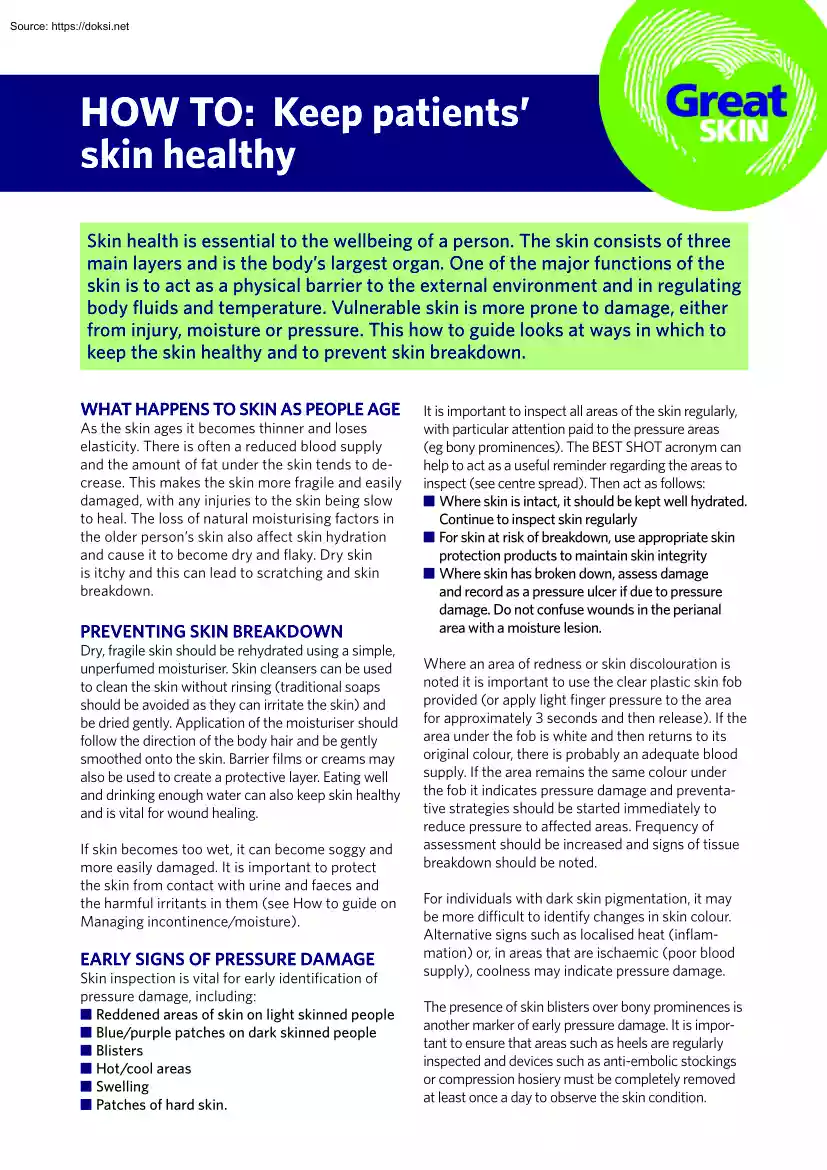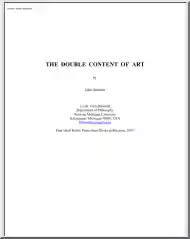A doksi online olvasásához kérlek jelentkezz be!

A doksi online olvasásához kérlek jelentkezz be!
Nincs még értékelés. Legyél Te az első!
Mit olvastak a többiek, ha ezzel végeztek?
Tartalmi kivonat
HOW TO: Keep patients’ skin healthy Skin health is essential to the wellbeing of a person. The skin consists of three main layers and is the body’s largest organ. One of the major functions of the skin is to act as a physical barrier to the external environment and in regulating body fluids and temperature. Vulnerable skin is more prone to damage, either from injury, moisture or pressure. This how to guide looks at ways in which to keep the skin healthy and to prevent skin breakdown. WHAT HAPPENS TO SKIN AS PEOPLE AGE As the skin ages it becomes thinner and loses elasticity. There is often a reduced blood supply and the amount of fat under the skin tends to decrease. This makes the skin more fragile and easily damaged, with any injuries to the skin being slow to heal. The loss of natural moisturising factors in the older person’s skin also affect skin hydration and cause it to become dry and flaky. Dry skin is itchy and this can lead to scratching and skin breakdown. PREVENTING
SKIN BREAKDOWN Dry, fragile skin should be rehydrated using a simple, unperfumed moisturiser. Skin cleansers can be used to clean the skin without rinsing (traditional soaps should be avoided as they can irritate the skin) and be dried gently. Application of the moisturiser should follow the direction of the body hair and be gently smoothed onto the skin. Barrier films or creams may also be used to create a protective layer. Eating well and drinking enough water can also keep skin healthy and is vital for wound healing. If skin becomes too wet, it can become soggy and more easily damaged. It is important to protect the skin from contact with urine and faeces and the harmful irritants in them (see How to guide on Managing incontinence/moisture). EARLY SIGNS OF PRESSURE DAMAGE Skin inspection is vital for early identification of pressure damage, including: ■ Reddened areas of skin on light skinned people ■ Blue/purple patches on dark skinned people ■ Blisters ■ Hot/cool areas
■ Swelling ■ Patches of hard skin. It is important to inspect all areas of the skin regularly, with particular attention paid to the pressure areas (eg bony prominences). The BEST SHOT acronym can help to act as a useful reminder regarding the areas to inspect (see centre spread). Then act as follows: ■ Where skin is intact, it should be kept well hydrated. Continue to inspect skin regularly ■ For skin at risk of breakdown, use appropriate skin protection products to maintain skin integrity ■ Where skin has broken down, assess damage and record as a pressure ulcer if due to pressure damage. Do not confuse wounds in the perianal area with a moisture lesion. Where an area of redness or skin discolouration is noted it is important to use the clear plastic skin fob provided (or apply light finger pressure to the area for approximately 3 seconds and then release). If the area under the fob is white and then returns to its original colour, there is probably an adequate blood
supply. If the area remains the same colour under the fob it indicates pressure damage and preventative strategies should be started immediately to reduce pressure to affected areas. Frequency of assessment should be increased and signs of tissue breakdown should be noted. For individuals with dark skin pigmentation, it may be more difficult to identify changes in skin colour. Alternative signs such as localised heat (inflammation) or, in areas that are ischaemic (poor blood supply), coolness may indicate pressure damage. The presence of skin blisters over bony prominences is another marker of early pressure damage. It is important to ensure that areas such as heels are regularly inspected and devices such as anti-embolic stockings or compression hosiery must be completely removed at least once a day to observe the skin condition. E BEST SHOT can be used as a reminder for assessment: ❏ Buttocks ❏ Elbows/ears ❏ Sacral area ❏ Trochanter (hips) ❏ Spine/shoulders ❏
Heels ❏ Occipital area (back of head) ❏ Toes hair 1 It is also important to assess the degree of fluid loss or dehydration by checking whether the skin (eg on the back of the hand) returns to normal shape when it is pinched. Regular skin assessment will help to inform the management plan. HOW TO KEEP SKIN HEALTHY Do’s and don’ts Do All individuals should have their skin assessed as part of a holistic assessment Have a regular schedule of daily skin inspection Look for any signs of skin irritation, blisters or red discolouration Use a compact mirror to visualise difficult to see areas such as the heels when the patient is in a chair Special attention should be paid to bony prominences and areas of skin that come into contact with devices such as catheters, masks etc Where an area of redness or skin discolouration is noted, refer to a qualified nurse or tissue viability nurse Distinguish between skin changes due to pressure damage and other
causes Manage dry skin conditions to keep skin hydrated Where skin changes are due to excessive moisture, use barrier products and other measures to keep skin clean and dry Use non-adherent dressings or tapes to protect fragile skin Document areas of pressure damage in the health records and implement pressure ulcer prevention plan Record any pressure ulcer prevention methods used Encourage and educate patients who are willing and able to inspect their own skin Do not Ignore signs of early skin damage (eg redness, swelling) Assume an area of discolouration is simply superficial damage. Deep tissue damage may present as an area of purple discolouration Delay implementation of a pressure ulcer prevention plan www.stopthepressurecom HOW TO KEEP SKIN HEALTHY IDENTIFYING PATIENTS AT RISK SSKIN Bundles Factors that may increase the risk of a patient developing a pressure ulcer include: ■ A history of a previous ulcer ■ Immobility ■ Sensory
loss (cannot feel pain) ■ Incontinence ■ Overweight or obese or very skinny ■ Recently undergone surgery ■ Dry, fragile skin ■ Poor diet and/or low water intake ■ Poor manual handling. Keeping patients moving is just one step of a simple five-step care plan (called a SSKIN bundle) to ensure all patients receive the appropriate care to prevent pressure damage. This includes: Skin injury due to slipping down a bed or chair can be minimised through correct repositioning and transferring of patients using appropriate manual handling aids when appropriate (see How to Guide on Keep Patients Moving). TOOLS FOR ASSESSING PRESSURE ULCER RISK Early recognition of individuals at risk of pressure ulceration is an essential part of prevention. Formal assessment of risk enables the correct interventions to be started and maintained. Common tools for identifying patients at risk include: ■ Braden Scale ■ Waterlow Risk Assessment Scale Identification of risk should trigger the use
of the SSKIN Bundle and/or a care plan. Individuals should be reassessed at regular intervals. If there is a change in their mental or physical status (eg person becomes bed- or chair-bound), this may increase their risk and a further assessment should be performed and appropriate measures taken. This may include changes to frequency of repositioning, a highergrade mattress or a change to the skin care plan. HOW THIS GUIDE CAN BE USED TO PREVENT PRESSURE ULCERS It is important to let others know what you are doing by documenting the results of skin inspection to identify patients at risk of developing a pressure ulcer. Accurate and complete documentation will help continuity of care and inform the skin care plan. Routine skin inspection plays a role in decreasing the incidence of pressure ulcers. Using the Safety Cross Using the pressure ulcer safety cross to measure incidents of pressure damage can help to raise awareness and change attitudes to pressure damage. Keep the safety
cross in a public area so that everyone can see it on a regular basis. This will show how many patients have developed a pressure ulcer in the care home. It should be used to record all pressure ulcers, regardless of grade and should help to identify improvements in care and reduce the number of pressure ulcers occurring. KEY POINTS 1. Keep skin clean, dry and well hydrated 2. Ensure ALL areas at risk are checked this may mean removing clothing and hosiery 3. Look for early signs of damage and implement preventative care straight away to prevent damage becoming deeper. KEY RESOURCES ■■ Best Practice Statement (2012) Caring for the Older Person’s Skin 2012. http://wwwwounds-uk-com ■■ How to: Pressure ulcer management (2012). http:// www.wounds-ukcom/how-to-guides/how-toguide-pressure-ulcer-management Wounds UK NICE guidelines (2005) Pressure ulcer management. http://www.niceorguk/CG029 ■■ SSKIN bundle. http://wwwstopthepressurecom/ sskin/ ■■ Safety cross
(http://www.patientsafetyfirstnhs uk/ashx/Asset.ashx?path=/PressureUlcers/ Pressure%20ulcer%20Safety%20Cross.pdf)
SKIN BREAKDOWN Dry, fragile skin should be rehydrated using a simple, unperfumed moisturiser. Skin cleansers can be used to clean the skin without rinsing (traditional soaps should be avoided as they can irritate the skin) and be dried gently. Application of the moisturiser should follow the direction of the body hair and be gently smoothed onto the skin. Barrier films or creams may also be used to create a protective layer. Eating well and drinking enough water can also keep skin healthy and is vital for wound healing. If skin becomes too wet, it can become soggy and more easily damaged. It is important to protect the skin from contact with urine and faeces and the harmful irritants in them (see How to guide on Managing incontinence/moisture). EARLY SIGNS OF PRESSURE DAMAGE Skin inspection is vital for early identification of pressure damage, including: ■ Reddened areas of skin on light skinned people ■ Blue/purple patches on dark skinned people ■ Blisters ■ Hot/cool areas
■ Swelling ■ Patches of hard skin. It is important to inspect all areas of the skin regularly, with particular attention paid to the pressure areas (eg bony prominences). The BEST SHOT acronym can help to act as a useful reminder regarding the areas to inspect (see centre spread). Then act as follows: ■ Where skin is intact, it should be kept well hydrated. Continue to inspect skin regularly ■ For skin at risk of breakdown, use appropriate skin protection products to maintain skin integrity ■ Where skin has broken down, assess damage and record as a pressure ulcer if due to pressure damage. Do not confuse wounds in the perianal area with a moisture lesion. Where an area of redness or skin discolouration is noted it is important to use the clear plastic skin fob provided (or apply light finger pressure to the area for approximately 3 seconds and then release). If the area under the fob is white and then returns to its original colour, there is probably an adequate blood
supply. If the area remains the same colour under the fob it indicates pressure damage and preventative strategies should be started immediately to reduce pressure to affected areas. Frequency of assessment should be increased and signs of tissue breakdown should be noted. For individuals with dark skin pigmentation, it may be more difficult to identify changes in skin colour. Alternative signs such as localised heat (inflammation) or, in areas that are ischaemic (poor blood supply), coolness may indicate pressure damage. The presence of skin blisters over bony prominences is another marker of early pressure damage. It is important to ensure that areas such as heels are regularly inspected and devices such as anti-embolic stockings or compression hosiery must be completely removed at least once a day to observe the skin condition. E BEST SHOT can be used as a reminder for assessment: ❏ Buttocks ❏ Elbows/ears ❏ Sacral area ❏ Trochanter (hips) ❏ Spine/shoulders ❏
Heels ❏ Occipital area (back of head) ❏ Toes hair 1 It is also important to assess the degree of fluid loss or dehydration by checking whether the skin (eg on the back of the hand) returns to normal shape when it is pinched. Regular skin assessment will help to inform the management plan. HOW TO KEEP SKIN HEALTHY Do’s and don’ts Do All individuals should have their skin assessed as part of a holistic assessment Have a regular schedule of daily skin inspection Look for any signs of skin irritation, blisters or red discolouration Use a compact mirror to visualise difficult to see areas such as the heels when the patient is in a chair Special attention should be paid to bony prominences and areas of skin that come into contact with devices such as catheters, masks etc Where an area of redness or skin discolouration is noted, refer to a qualified nurse or tissue viability nurse Distinguish between skin changes due to pressure damage and other
causes Manage dry skin conditions to keep skin hydrated Where skin changes are due to excessive moisture, use barrier products and other measures to keep skin clean and dry Use non-adherent dressings or tapes to protect fragile skin Document areas of pressure damage in the health records and implement pressure ulcer prevention plan Record any pressure ulcer prevention methods used Encourage and educate patients who are willing and able to inspect their own skin Do not Ignore signs of early skin damage (eg redness, swelling) Assume an area of discolouration is simply superficial damage. Deep tissue damage may present as an area of purple discolouration Delay implementation of a pressure ulcer prevention plan www.stopthepressurecom HOW TO KEEP SKIN HEALTHY IDENTIFYING PATIENTS AT RISK SSKIN Bundles Factors that may increase the risk of a patient developing a pressure ulcer include: ■ A history of a previous ulcer ■ Immobility ■ Sensory
loss (cannot feel pain) ■ Incontinence ■ Overweight or obese or very skinny ■ Recently undergone surgery ■ Dry, fragile skin ■ Poor diet and/or low water intake ■ Poor manual handling. Keeping patients moving is just one step of a simple five-step care plan (called a SSKIN bundle) to ensure all patients receive the appropriate care to prevent pressure damage. This includes: Skin injury due to slipping down a bed or chair can be minimised through correct repositioning and transferring of patients using appropriate manual handling aids when appropriate (see How to Guide on Keep Patients Moving). TOOLS FOR ASSESSING PRESSURE ULCER RISK Early recognition of individuals at risk of pressure ulceration is an essential part of prevention. Formal assessment of risk enables the correct interventions to be started and maintained. Common tools for identifying patients at risk include: ■ Braden Scale ■ Waterlow Risk Assessment Scale Identification of risk should trigger the use
of the SSKIN Bundle and/or a care plan. Individuals should be reassessed at regular intervals. If there is a change in their mental or physical status (eg person becomes bed- or chair-bound), this may increase their risk and a further assessment should be performed and appropriate measures taken. This may include changes to frequency of repositioning, a highergrade mattress or a change to the skin care plan. HOW THIS GUIDE CAN BE USED TO PREVENT PRESSURE ULCERS It is important to let others know what you are doing by documenting the results of skin inspection to identify patients at risk of developing a pressure ulcer. Accurate and complete documentation will help continuity of care and inform the skin care plan. Routine skin inspection plays a role in decreasing the incidence of pressure ulcers. Using the Safety Cross Using the pressure ulcer safety cross to measure incidents of pressure damage can help to raise awareness and change attitudes to pressure damage. Keep the safety
cross in a public area so that everyone can see it on a regular basis. This will show how many patients have developed a pressure ulcer in the care home. It should be used to record all pressure ulcers, regardless of grade and should help to identify improvements in care and reduce the number of pressure ulcers occurring. KEY POINTS 1. Keep skin clean, dry and well hydrated 2. Ensure ALL areas at risk are checked this may mean removing clothing and hosiery 3. Look for early signs of damage and implement preventative care straight away to prevent damage becoming deeper. KEY RESOURCES ■■ Best Practice Statement (2012) Caring for the Older Person’s Skin 2012. http://wwwwounds-uk-com ■■ How to: Pressure ulcer management (2012). http:// www.wounds-ukcom/how-to-guides/how-toguide-pressure-ulcer-management Wounds UK NICE guidelines (2005) Pressure ulcer management. http://www.niceorguk/CG029 ■■ SSKIN bundle. http://wwwstopthepressurecom/ sskin/ ■■ Safety cross
(http://www.patientsafetyfirstnhs uk/ashx/Asset.ashx?path=/PressureUlcers/ Pressure%20ulcer%20Safety%20Cross.pdf)




 Megmutatjuk, hogyan lehet hatékonyan tanulni az iskolában, illetve otthon. Áttekintjük, hogy milyen a jó jegyzet tartalmi, terjedelmi és formai szempontok szerint egyaránt. Végül pedig tippeket adunk a vizsga előtti tanulással kapcsolatban, hogy ne feltétlenül kelljen beleőszülni a felkészülésbe.
Megmutatjuk, hogyan lehet hatékonyan tanulni az iskolában, illetve otthon. Áttekintjük, hogy milyen a jó jegyzet tartalmi, terjedelmi és formai szempontok szerint egyaránt. Végül pedig tippeket adunk a vizsga előtti tanulással kapcsolatban, hogy ne feltétlenül kelljen beleőszülni a felkészülésbe.